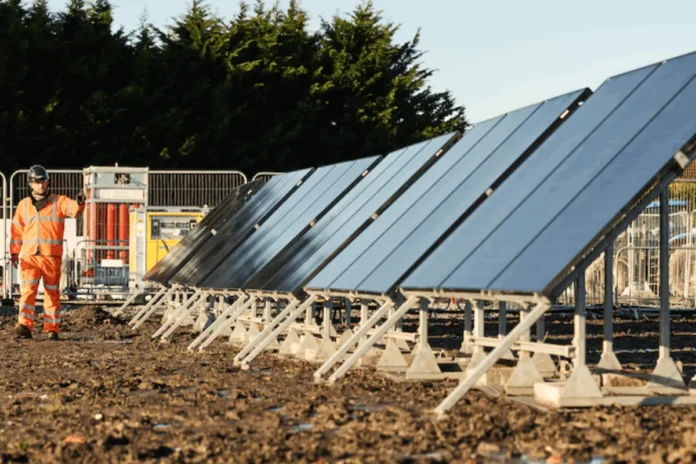In a groundbreaking move for construction site energy, Kier and the Environment Agency have unveiled early success from a pioneering 12-month trial that replaces traditional diesel generators with an innovative blend of solar power, green hydrogen fuel cells, and battery storage. The trial—hosted at the Bridgwater Tidal Barrier scheme in Somerset—examines whether off-grid sites can sustainably run welfare and office facilities with a completely new energy strategy.
A New Era in Construction Energy
Launched at a £250m project on the Somerset coast, this trial is redefining how construction sites are powered. In its first few months, the system generated a total of approximately 16,000 kWh of clean energy. Detailed data reveals that the mix contributed around 6,600 kWh from solar panels, 9,100 kWh from hydrogen fuel cells, and a modest 300 kWh from battery reserves. These precise figures highlight not only the technical viability of this renewable setup but also its capacity to significantly reduce reliance on diesel power.
For context, compared to a conventional diesel generator, the trial has already conserved roughly 20,000 litres of diesel. This remarkable reduction has prevented about 53 tonnes of CO₂ emissions—a saving akin to driving 195,000 miles in a diesel car or offsetting the emissions from 350 one-way flights between London and Glasgow. Alongside environmental benefits, the new energy solution also minimizes noise pollution and eliminates the risks associated with diesel spills.
Industry Voices on Renewable Energy Progress
Industry professionals are quick to applaud this initiative. Jo Driffield, Senior Engineer at the Environment Agency, remarked,
> “This trial is a vital stride in achieving our net zero objectives. It clearly underlines the growing demand for green hydrogen, an essential element in decarbonising construction and driving sustainable practices.”
TCP Group, the supplier of the hybrid power system, is equally enthusiastic. Managing Director Andrew Barker explained that this project marks TCP’s largest hybrid hydrogen welfare solution to date—a testament to the transformative potential of integrating clean technologies on a large scale. Kier’s Hannah McIlroy added that close collaboration with clients and the supply chain is paving the way for further decarbonisation initiatives industrywide.
Energy Breakdown Table
Below is a clear overview of the energy mix recorded during the initial months of testing:
| Energy Source | Energy Produced (kWh) | Notes |
|---|---|---|
| Solar Power | 6,600 | Generates power directly from sunlight |
| Green Hydrogen Fuel | 9,100 | Provided backup and primary energy support |
| Battery Storage | 300 | Supplements power during fluctuations |
| Total | 16,000 | Reflects overall test performance |
This table provides both an at-a-glance view and a detailed breakdown of the trial’s successful output.
The Broader Significance for Clean Energy in Construction
By replacing diesel with renewable technologies, the initiative is setting a new standard in the construction industry. The clean energy solution not only cuts emissions substantially but also improves operational efficiency and site safety. As pioneers in electric mobility and sustainable technologies, Kier and its partners are demonstrating that a green future is both achievable and advantageous. This project echoes a broader trend toward integrating renewable energy into high-demand industries, paving the way for scalable solutions that can be replicated globally.
Future Outlook and Industry Implications
The early stages of this trial signal a monumental shift in energy practices across construction sites. The robust data and savings achieved so far provide a strong foundation for future research and investment into solar-hydrogen hybrid systems. As more companies adopt these innovative solutions, the cumulative impact on reducing emissions and fostering cleaner energy practices will only grow.
Kier’s commitment to forging sustainable paths forward, coupled with the insights gained from this trial, offers a promising blueprint for future energy policies in the construction sector. With the combined efforts of industry veterans and innovative technology partners, the path to a net zero future becomes not just a goal, but an imminent reality.
Written by CommaFast – your trusted source for cutting-edge insights into technology and electric mobility.




